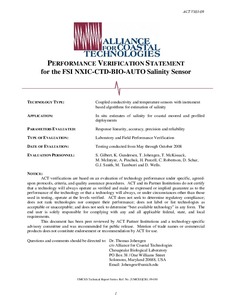| dc.contributor.author | Gilbert, S. | |
| dc.contributor.author | Gundersen, K. | |
| dc.contributor.author | Johengen, T. | |
| dc.contributor.author | McKissack, T. | |
| dc.contributor.author | McIntyre, M. | |
| dc.contributor.author | Pinchuk, A. | |
| dc.contributor.author | Purcell, H. | |
| dc.contributor.author | Robertson, C. | |
| dc.contributor.author | Schar, D. | |
| dc.contributor.author | Smith, G.J. | |
| dc.contributor.author | Tamburri, M. | |
| dc.contributor.author | Wells, D. | |
| dc.date.accessioned | 2019-01-21T12:50:29Z | |
| dc.date.available | 2019-01-21T12:50:29Z | |
| dc.date.issued | 2008 | |
| dc.identifier.citation | Gilbert, S.; Gundersen, K.; Johengen, T.; McKissack, T.; McIntyre, M.; Pinchuk, A.; Purcell, H.; Robertson, C.; Schar, D.; Smith, G.J.; Tamburri, M. and Wells, D. (2008) Performance Verification Statement for the FSI NXIC-CTD-BIO-AUTO Salinity Sensor. Solomons, MD, Alliance for Coastal Technologies, 63pp. (ACTVS03-09). DOI: http://dx.doi.org/10.25607/OBP-325 | en_US |
| dc.identifier.uri | http://hdl.handle.net/11329/768 | |
| dc.identifier.uri | http://dx.doi.org/10.25607/OBP-325 | |
| dc.description.abstract | Instrument performance verification is necessary so that effective existing technologies can be
recognized, and so that promising new technologies can become available to support coastal science,
resource management, and ocean observing systems. The Alliance for Coastal Technologies (ACT) has
therefore completed an evaluation of commercially available in situ salinity sensors. While the sensors
evaluated have many potential applications, the focus of this Performance Verification was on nearshore
moored and profiled deployments and at a performance resolution of between 0.1 – 0.01 salinity units.
In this Verification Statement, we present the performance results of the FSI NXIC salinity
sensors evaluated in the laboratory and under diverse environmental conditions in moored and profiling
field tests. A total of one laboratory site and five different field sites were used for testing, including
tropical coral reef, high turbidity estuary, sub-tropical and sub-arctic coastal ocean, and freshwater
riverine environments. Quality assurance (QA) oversight of the verification was provided by an ACT QA
specialist, who conducted technical systems audits and a data quality audit of the test data.
In the lab tests, the NXIC exhibited a strong linear response when exposed to 15 different test
conditions covering five salinities ranging from 7 – 34 psu, each at three temperatures ranging from 6 - 32
o
C with R2 = 0.9996, SE = 0.222 and slope = 0.987. The overall mean and variance of the absolute
difference between instrument measured salinity and reference sample salinity for all treatments was
-0.2180 ±0.2543 psu. When examined independently, the relative accuracy of the conductivity and
temperature sensors were -0.2882 ±0.3303 mS/cm and -0.0073 ±0.0034 oC, respectively.
Across all four field deployments, the range of salinity tested against was 0.14 – 36.97. The
corresponding conductivity and temperatures ranges for the tests were 0.27 – 61.69 mS cm-1 and 10.75 –
31.14 oC, respectively. The mean absolute difference between instrument measured salinity and reference
sample salinity over the entire deployment period was -0.1116, -0.7204, -0.0018, -0.3341 and -0.0179 psu
for FL, GA, HI, MI, and AK, respectively. However, these averages include the impacts of biofouling
and much higher accuracy was observed at the onset of each field test. Also, the significantly greater
offset at the AK test was likely due to fine-scale vertical variation within the water column which resulted
in real differences between in situ measured and reference sample salinities and not due to a difference in
instrument performance. Despite our best effort to sample as close as possible to the sensors, the
collected reference samples may not have been homogeneous with the water mass measured by the
sensor. Overall patterns in measured salinity still show excellent agreement at this site. When instrument
response for the first 14 days of deployment was compared together for all five field sites, a fairly
consistent and linear performance response was observed with R2 = 0.999, SE = 0.353 and slope = 0.998.
These results are quite consistent with those from the laboratory tests.
Performance checks were completed prior to field deployment and again at the end of the
deployment, after instruments were thoroughly cleaned of fouling, to evaluate potential calibration drift
versus biofouling impacts. On several occasions results of these tests were compromised, most likely
because of entrainment of air bubbles in the conductivity cell. In general, there was no strong evidence
for calibration drift during the period of deployment.
During this evaluation, one hundred percent of the data was recovered from the instrument
during the laboratory tests, all field deployment tests, and all tank exposure tests. Lastly, a check on the
instruments time clocks at the beginning and end of field deployments showed differences of between
minus 1 to minus 30 seconds among test sites.
We encourage readers to review the entire document for a comprehensive understanding
of instrument performance. | en_US |
| dc.language.iso | en | en_US |
| dc.publisher | Alliance for Coastal Technologies (ACT) | en_US |
| dc.relation.ispartofseries | ACT VS; 03-09 | |
| dc.rights | CC0 1.0 Universal | * |
| dc.rights.uri | http://creativecommons.org/publicdomain/zero/1.0/ | * |
| dc.title | Performance Verification Statement for the FSI NXIC-CTD-BIO-AUTO Salinity Sensor. | en_US |
| dc.type | Report | en_US |
| dc.description.status | Published | en_US |
| dc.format.pages | 63pp. | en_US |
| dc.description.refereed | Refereed | en_US |
| dc.publisher.place | Solomons, MD | en_US |
| dc.subject.parameterDiscipline | Biogeochemistry | en_US |
| dc.description.currentstatus | Current | en_US |
| dc.description.eov | Sea surface salinity | en_US |
| dc.description.eov | Subsurface salinity | |
| dc.description.bptype | Best Practice | en_US |
| dc.description.bptype | Standard Operating Procedure | en_US |
| obps.contact.contactemail | info@act-us.info | |
| obps.contact.contactemail | Johengen@umich.edu | |
| obps.resourceurl.publisher | http://www.act-us.info/evaluations.php | en_US |
 Repository of community practices in Ocean Research, Applications and Data/Information Management
Repository of community practices in Ocean Research, Applications and Data/Information Management

